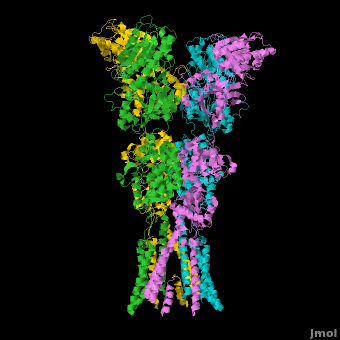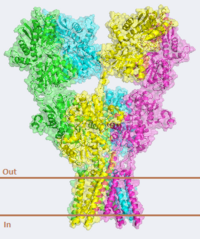Introduction
Ionotropic Glutamate Receptors (IGluRs) are a family of ligand-gated ion channels that are responsible for fast excitatory neurotransmission.[1] Primarily localized to nerve synapses in mammals, IGluRs are implicated in nearly all aspects of nervous system development and function.[2] Synapses form the connection between two neuronal cells. Within synapses, neurotransmitters are released from vesicles in presynaptic cells and interact with receptors in postsynaptic cells to allow for communication between nerve cells.[1] GluR domains include the amino terminal domain (ATD), transmembrane domain (TMD) and ligand-binding domain (LBD). Glutamate is the predominant neurotransmitter of excitatory synapses and interacts specifically with AMPA and NMDA IGluRs.[3]
- AMPA receptor is a non-NMDA-type IGluR
- Kainate receptor (GluK) is a non-NMDA-type IGluR which is activated by the agonist kainate.
- NMDA receptor (NMDAR) is a IGluR which binds to the agonist NMDA. It contains subuntis NR1, NR2A, NR2B, NR2C, NR2D, NR3A, NR3B.
- GluD receptors do not bind glutamate[4].
Additional details in
Involvement in Autism Spectrum Disorders
Autism Spectrum Disorders (ASDs) are neurodevelopmental disorders. During development, glutamate regulates neuronal growth and synaptogenesis, effectively dictating the underlying connective neuronal architecture of the brain.[3] Significant research into ASDs has been devoted to understanding how glutamate receptors function and how disruption leads to neurodevelopmetnal disorders. IGluRs are concentrated in regions of the brain that have been implicated in ASDs including the cerebellum and hippocampus. These are the areas responsible for motor control, spatial navigation and memory, attributes that are often disrupted in patients with ASDs. Studies have revealed that glutamate receptor expression is increased in the cerebellum of autistic individuals by nearly 250%. A number of small nucleotide polymorphisms in IGluRs have also been identified which correlate with the ASDs. Further, many people with autism have clearly visible disturbances in the inferior olive (IO) in the brain. The IO plays a critical role in movement coordination and maintenance of an underlying 12 Hz brain rhythm through careful regulation of glutamate signaling.[5] A well-known mouse model called “Lurcher” for the lurching type movements the mice make has served as an important model for studying ASDs. The mutation that causes the “Lurcher” phenotype creates a constitutively leaky glutamate receptor ion channel resulting in IO neuron degeneration and loss of purkinje cells. These mice exhibit some of the well-known Autism-like characteristics.[6] Such relationships between overly active glutamate receptors leading to increased excitation/inhibition ratios and autism have led some to propose using glutamate receptor inhibitors as a means of pharmaceutical intervention for improving those with autistic symptoms.[7] Many pharmacological agents that reduce neural excitation, such as benzodiazapines, are thought to potentially have therapeutic value in treating autistic symptoms.[3]
GluA2 Structure
AMPA IGluRs form composed of and . Each subunit includes an extracellular (ATD) which is responsible for receptor trafficking within the membrane, a (LBD) which activates the receptor upon binding glutamate, and a (TMD) which forms the membrane-spanning ion channel. Also present is a carboxy-terminal domain involved in receptor localization and regulation, although the structure of this domain has not been solved.[2] The structure of AMPA IGluRs or in this case GluA2, is unique in that the . The ATD has a local two-fold symmetry, the LBD has a two-fold symmetry, while the TMD has a four-fold symmetry. Here is a morph depicting the . This symmetry mismatch has implications for function of the receptor with subunits behaving differently depending upon their orientation despite identical primary sequence.[2] For an excellent analysis, see: Glutamate Receptor Symmetry Analysis
The Amino Terminal Domain
is responsible for receptor assembly, trafficking and localization. It has two unique sets of interactions which hold the tetramer together. The is present in each pair of dimers and involves both hydrogen bonding and hydrophobic interactions. The , which includes residues Ile 203, Thr 204, Ile 205, and Val 209 on both chains among others, effectively holds the pair of dimers together at an angle that is roughly 24 degrees off of the overall two-fold axis.[2][8]
The Transmembrane Domain
has a pore structure that is nearly identical to that of the Potassium Channel. With complete four-fold symmetry, 16 helices form a through which cations can flow through. In the current, inhibitor bound structure, the at a highly conserved , with Thr 617, Ala 621, and Thr 625 occluding the ion permeation pathway.[2] The of the channel includes the residues Thr 625, Ala 621, and Thr 617, but does not distinguish between positive cations like in the Potassium Channel. Located next to this narrow region lies , which is replaced with a threonine in the Lurcher mouse model mentioned previously. This mutation, which introduces a much bulkier residue, prevents the helices from closing properly, resulting in a constitutively open ion channel.[2]
The Ligand Binding Domain
is located just above the TMD and has an overall . Within each LBD lies the so-called . This structure is responsible for and “sensitizing” the receptor to allow passage of cations through the channel. Residues Pro 89, Leu 90, Arg 96, Ser 142, & Glu 193 among others (residue numbers in 1ftj model), which are responsible for within the clamshell, are highly conserved. Glutamate binding causes a () in the LBD which pulls the M3 helices in the TMD apart, opening the channel and allowing for cation passage. A morph of the conformational change in the LBD upon glutamate binding can be . Uniquely, due to the varied importance of the homotetramer subunits due to symmetry mismatch, the interaction of glutamate with the distal subunits is predicted to result in a greater conformational change. Thus these distal subunits play a more critical role in channel sensitization and activation.[2]
Pharmaceutical Relevance
As mentioned previously, extensive investigation into the pharmaceutical potential of IGluRs as a target for treating various ailments including Autism Spectrum Disorders symptoms is ongoing. In addition to agents which reduce neural excitation such as benzodiazapines, small molecules that potentiate AMPA receptor currents have been proven to reduce cognitive deficits caused by neurodegenerative diseases such as Alzheimer's Disease.[3] See also Memantine. Modulators such as aniracetam and CX614 (2al4) of the ligand-binding core through interactions with a “proline ceiling” and a “serine floor”, stabilizing the closed-clamshell conformation. Although these compounds would likely be ineffective in the case of Autism patients because they slow the deactivation of the IGluR channels, this class of compounds has exciting therapeutic potential.[1]. The glutamate receptor inhibitor Diuril is used as drug in cases of hypertension, edema, diabetes insipidus and kidney stones[9].
3D structures of glutamate receptor
Glutamate receptor 3D structures


